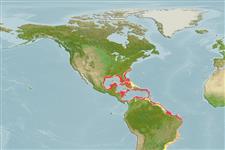Environment: milieu / climate zone / depth range / distribution range
Ecologia
marinhas associadas(os) a recifes; intervalo de profundidade 3 - 213 m (Ref. 5222), usually 3 - 35 m (Ref. 40849). Subtropical; 37°N - 30°S, 98°W - 30°W (Ref. 89707)
Western Atlantic: North Carolina, USA to Rio de Janeiro, Brazil, including the Gulf of Mexico and the Caribbean.
Tamanho / Peso / Idade
Maturity: Lm ? range ? - ? cm
Max length : 91.0 cm TL macho/indeterminado; (Ref. 7251); common length : 50.0 cm TL macho/indeterminado; (Ref. 5217); peso máx. Publicado: 10.0 kg (Ref. 5222)
Espinhos dorsais (total): 11; Raios dorsais moles (total): 18-20; Espinhos anais 3; Raios anais moles: 8 - 10. Distinguished by the following characteristics: body and fins black with many large white blotches (Ref. 13608). Compressed, with a large pectoral fin; scales smooth (Ref. 26938); greatest depth of body 2.2-2.5 in SL; body width 2.2-2.9 times in depth; head length 2.5-2.8 times in SL; rounded preopercle, finely serrate, serrae at the angle slightly enlarged (Ref. 089707).
Usually on deep ledges, at depths to 210 m and on reefs, usually in caves or deep crevices (Ref. 7251). Solitary (Ref. 26340) and secretive, darts away when approached or frightened (Ref. 9710). Rarely seen in markets. Major threat to this species is fishing pressure (Ref. 089707).
Life cycle and mating behavior
Maturidade | Reprodução | Desova | Ovos | Fecundidade | Larvas
Heemstra, P.C. and J.E. Randall, 1993. FAO Species Catalogue. Vol. 16. Groupers of the world (family Serranidae, subfamily Epinephelinae). An annotated and illustrated catalogue of the grouper, rockcod, hind, coral grouper and lyretail species known to date. Rome: FAO. FAO Fish. Synop. 125(16):382 p. (Ref. 5222)
Categoria na Lista Vermelha da IUCN (Ref. 130435)
Ameaça para o homem
Harmless
Utilização humana
Pescarias: pouco comercial
Mais informação
Nomes comunsSinónimosMetabolismoPredadoresEcotoxicologiaReproduçãoMaturidadeDesovaAgregação para desovaFecundidadeOvosDesenvolvimento dos ovos
ReferênciasAquaculturaPerfil para aquaculturaEstirpesGenéticaElectrophoresesHereditariedadeDoençasProcessamentoNutrientsMass conversion
Ferramentas
Relatórios especiais
Descarregue XML
Fontes da internet
Estimates based on models
Preferred temperature (Ref.
123201): 23.6 - 28, mean 26.7 °C (based on 502 cells).
Phylogenetic diversity index (Ref.
82804): PD
50 = 0.6250 [Uniqueness, from 0.5 = low to 2.0 = high].
Bayesian length-weight: a=0.00851 (0.00469 - 0.01544), b=3.15 (2.99 - 3.31), in cm total length, based on LWR estimates for this species & (Sub)family-body (Ref.
93245).
Nível Trófico (Ref.
69278): 4.5 ±0.80 se; based on food items.
Resiliência (Ref.
120179): Baixo, tempo mínimo de duplicação da população 4,5 - 14 anos (Preliminary K or Fecundity.).
Fishing Vulnerability (Ref.
59153): High vulnerability (56 of 100).
Nutrients (Ref.
124155): Calcium = 12.2 [6.0, 27.3] mg/100g; Iron = 0.421 [0.213, 0.872] mg/100g; Protein = 18.9 [16.9, 20.7] %; Omega3 = 0.179 [0.098, 0.340] g/100g; Selenium = 24.1 [10.0, 51.5] μg/100g; VitaminA = 48 [11, 248] μg/100g; Zinc = 0.418 [0.261, 0.666] mg/100g (wet weight);
